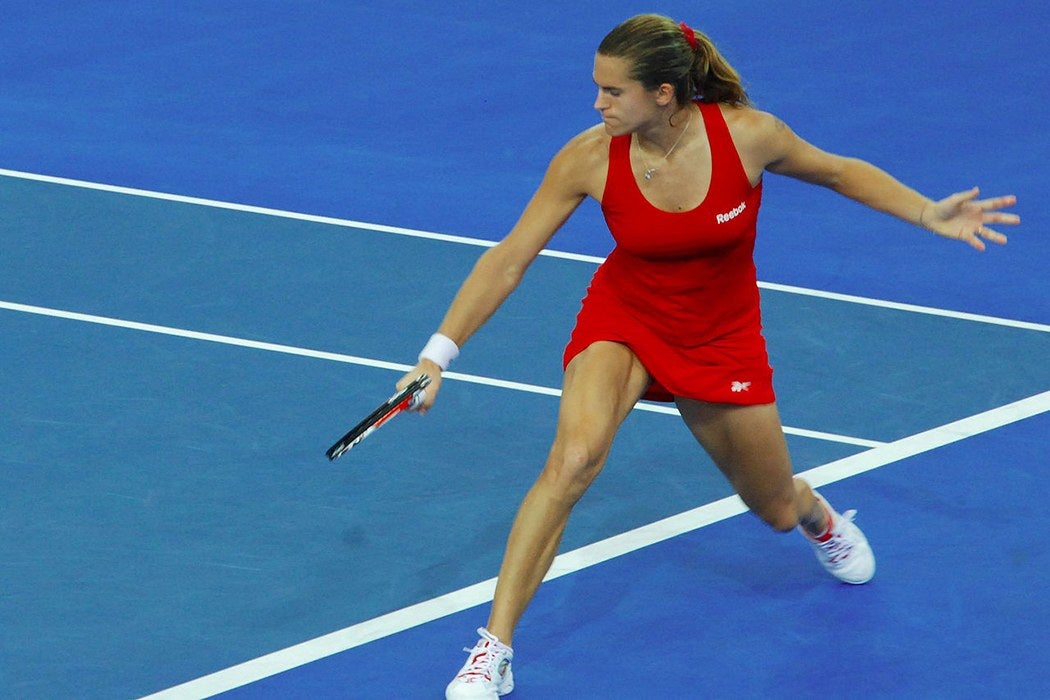If you tune into Wimbledon this year, you’ll see all the trappings of tennis’s most revered tournament: grass courts, champagne-sipping attendees, and some of the world’s most athletic women. But look a little closer: As Pamela J. Forman and Darcy C. Plymire know, tennis is about more than tennis. They investigate the case of Amélie Mauresmo to illustrate the complex sexual politics that play out on both women’s bodies and the grass courts of Wimbledon.
Mauresmo is a two-time Grand Slam champion and Olympic silver medalist who is also known for coaching Andy Murray. After she beat top seed Lindsey Davenport in 1999, she came out as a lesbian—and her body became a rhetorical battleground. She was repeatedly described as bulging, muscular, and intimidating—and Davenport’s bitter mention that playing her was like “playing a guy” was repeated in coverage of her game.
To Forman and Plymire, it’s an example of “a moral panic over the lesbian body,” one that’s been part of the sport since Billie Jean King came out in the early 1980s. It also calls one of tennis’ most infuriating failures—its insistence on capitalizing on the sex appeal of women players—into question. “Certainly, Mauresmo is not the only woman player who is better known for her sexuality than her tennis,” they write. Think Anna Kournekova, whom Jeanette Winterson ironically noted “is so weighed down with tabloid adjectives – ‘pouting’, ‘sizzling’, ‘tasty’—it’s a wonder she can lift her racket.”
Mauresmo’s sexuality is lesbian, though, and it’s been celebrated. “By coming out as a lesbian and fitting certain stereotypical notions of masculine lesbianism,” Plymire and Forman write, “Mauresmo allows the press, advertisers, and women’s tennis symbolically to demonstrate their sympathy with women’s issues while differentiating the real lesbian from other strong women on tour.” They characterize her as a “butch hero,” one whose potential threat to the social order is contained within a narrative of glamour, strength, and triumph that paints her coming out as a glorious act of courage and every win as a doubly significant strike against a harsh public.
Fans who discuss Mauresmo online defend her and express the wish that she’d be embraced by the tennis establishment. But by doing so, Forman and Plymire warn, they’re abandoning any truly progressive possibilities for a rare out tennis star. “As long as the lesbian tennis player can live the same life of leisure as other professional women athletes, all is well, it seems,” they write.
Weekly Digest
In the commodity-driven culture that is tennis, the authors imply, there’s no room for a narrative that falls outside strictly defined norms. That’s reflected by Mauresmo herself. She has since spoken out about her experiences as a lesbian, telling The Guardian’s Louise France that being gay was something her fans have had to overcome:
She says she understands why more gay sportsmen and women don’t come out, even though the culture is more liberal than it was in the Seventies and Eighties. “I know how difficult it is. Now I am lucky that people just see me as a great player and a nice person. I think they have gone beyond this gay thing. But it is hard. I was judged.”
Mauresmo isn’t the only woman to struggle with gender, sex, and sexuality on court. Just look at Serena Williams, who won her 23rd Grand Slam title while pregnant. That feat seems to have set notorious pout John McEnroe on edge: He recently claimed that Williams—who is widely considered one of the world’s greatest living athletes—might come in 700th place if she played on the men’s circuit. Perhaps one day being gay on the court will be no big deal. But for now, women’s sexuality—gay or straight—is Wimbledon’s elephant on the grass.







